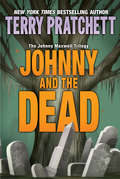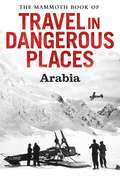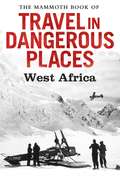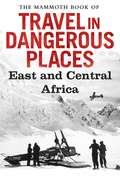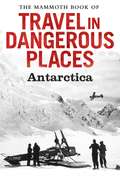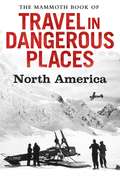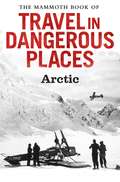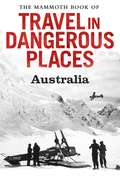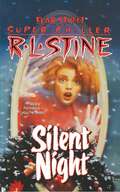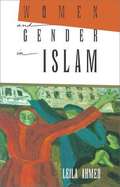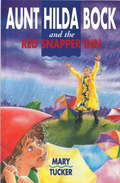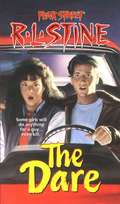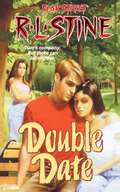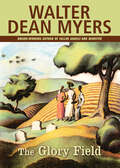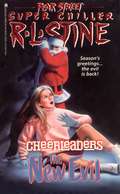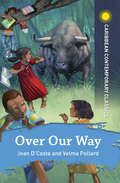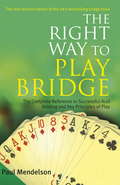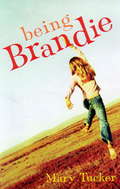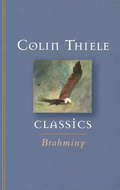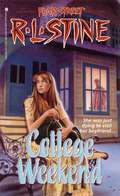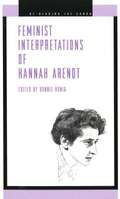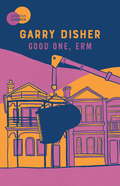- Table View
- List View
Johnny and the Dead (Johnny Maxwell Trilogy #2)
by Terry PratchettSir Terry Pratchett, beloved and bestselling author of the Discworld fantasy series, explores the bonds between the living and the dead and proves that it's never too late to have the time of your life—even if it is your afterlife!Johnny Maxwell's new friends do not appreciate the term "ghosts," but they are, well, dead.The town council wants to sell the cemetery, and its inhabitants aren't about to take that lying down! Johnny is the only one who can see them, and and the previously alive need his help to save their home and their history. Johnny didn't mean to become the voice for the lifeless, but if he doesn't speak up, who will?Read more of Johnny Maxwell's adventures in Only You Can Save Mankind and Johnny and the Bomb!
The Mammoth Book of Travel in Dangerous Places: Arabia
by John KeayEscape from Riyadh - William Gifford PalgraveA scholar and a solider, a Jesuit and a Jew, a French spy and a British ambassador- Palgrave was a man of contradictions, all of them highly compromised when in 1862-3, fortified by Pius IX's blessing and Napoleon III's cash, he attempted the first west- east crossing of the Arabian peninsular. To steely nerves and a genius for disguise he owed his eventual success; but not before both were sorely tested when, as a Syrian doctor, he became the first European to enter Riyadh. The desert capital of the fanatical Wahabis, dangerous for an infidel at the best of times, was then doubly so as the sons of the ageing King Feisal intrigued for power.Desert Days - Charles Montagu DoughtyDuring two years (1875-7) wandering in Central Arabia Doughty broke little new ground; dependant on desert charity, his achievement was simply to have survived. Yet his book, Arabia Deserta, was instantly recognized as a classic. Its eccentric prose proves well suited to that minute observation and experience of Bedouin life which was Doughty's main contribution to exploration. T.E. Lawrence called it "a bible of a kind"; both syntax and subject matter have biblical resonances, as in this description of a day's march, or rahla.
The Mammoth Book of Travel in Dangerous Places: West Africa
by John KeayAlone in Africa - Mungo ParkPark's 1795-7 odyssey in search of the Niger first awakened the world to the feasibility of a white man penetrating sub-Saharan Africa. But unlike his illustrious successors, this quiet tenant farmer's son from the Scottish Borders travelled alone; relieved of his meager possessions, he was soon wholly dependant on local hospitality. In what he called "a plain unvarnished tale" he related horrific ordeals with admirable detachment - never more tested than on his return journey through Bamako, now the capital of Mali.The Road to Kano - Hugh ClappertonIn one of exploration's unhappier sagas two Scots, Captain Hugh Clapperton and Dr. Walter Oudney, were saddled with the unspeakable Major Dixon Denham on a three year journey to Lake Chad and beyond. Clapperton mapped much of northern Nigeria and emerged with credit. Major Denham also excelled himself, twice absconding, then accusing Oudney of incompetence and Clapperton of buggery. Happily the Major was absent in 1824, after nursing his dying friend, Clapperton became the first European to reach Kano.Down the Niger - Richard LanderAs Clapperton's manservant, Lander attended his dying master on his 1825 expedition to the Niger and was then commissioned, with his brother John, to continue the exploration of the river. The mystery of its lower course was finally solved when in 1831 they sailed down through Nigeria to the delta and the sea. Unassuming Cornishmen, the Landers approached their task with a refreshing confidence in goodwill of Africans. It paid of in a knife-edge encounter at the confluence of the Benoue, although Richard subsequently paid the price with his life.Arrival in Timbuktu - Heinrich BarthBorn in Hamburg, Barth was already an experienced traveler and a methodical scholar when in 1850 he joined a British expedition to investigate Africa's internal slave trade. From Tripoli the expedition crossed the Sahara to Lake Chad. Its leader died but Barth continued on alone, exploring vast tract of the Sahel from northern Cameroon to Mali. Timbuktu, previously visited only by A.G. Laing and René Caillié, provided the climax as Barth, in disguise, approached the forbidden city by boat from the Niger.My Ogowé Fans - Mary KingsleySelf-educated while she nursed her elderly parents, Mary Kingsley had known only middle-class English domesticity until venturing to West Africa in 1892. Her parents had died and, unmarried, she determined to study "fish and fetish" for the British Museum. Her 1894 ascent of Gabon's Ogowé River (from Travels in West Africa, 1897) established her a genuine pioneer and an inimitable narrator. She died six years later while nursing prisoners during the Boer War.
The Mammoth Book of Travel in Dangerous Places: East and Central Africa
by John KeayAmong the Sudanese - James BruceBruce reached the source of the Blue Nile in 1771, a century before the search for the source of the White Nile became headline news. His descriptions of the cruelties and orgies at Gondar, the Ethiopian capital, were greeted with disbelief; so was his account of the Sudanese rulers, and their queens, at Sennar. He was later shown to be an accurate observer as well as the eighteenth century's most intrepid traveller.Not the Source of the Nile - Richard Francis BurtonIn Burton a brilliant mind and dauntless physique were matched with a restless spirit and a deeply troubled soul to produce the most complex of characters. Contemptuous of other mortals, including Speke, his companion and rival, he found solace only in the extremities of erudition and adventure. A Glimpse of Lake Victoria - John Hanning SpekeIn July 1858, while returning from Lake Tanganyika with Burton, Speke made a solo excursion to the north in search of an even larger lake reported by an Arab informant. Although partially blind and unable to ascertain its extent, he named this lake "Victoria" and boldly declared it the long sought source of the White Nile. The Reservoir of the Nile - Samuel White BakerAmongst professional explorers and big game hunters, none was as successful as Baker. A bluff and plausible figure, wealthy and resourceful, he conducted his explorations on the grand scale, invariably reached his goal and invariably reaped the rewards.Last Days - David LivingstoneLivingstone was nurtured in poverty and religious fervour. He reached southern Africa as a missionary doctor but, more suited to solitary exploration, edged north in a series of pioneering journeys into the interior. Encounters on the Upper Congo - Henry Morton StanleyStanley made his name as an explorer by tracking down Livingstone in 1871. But obscure Welsh origins, plus the adoption of US citizenship and professional journalism, did not endear him to London's geographical establishment. His response was to out-travel all contemporaries, beginning with the first ever coast-to-coast crossing of equatorial Africa. A Novice at Large - Joseph ThomsonBarely twenty and just out of Edinburgh University, Thompson was unexpectedly employed on the Royal Geographical Society's 1878 expedition to the Central African lakes. Unlike Burton he admired Africans; unlike Stanley he would not fight them. His motto - "he who goes slowly, goes safely; he who goes safely, goes far" - was never more seriously tested that when, just six weeks inland from Dar es Salaam, his first expedition lost Keith Johnston, its leader and Thompson's only European companion.
The Mammoth Book of Travel in Dangerous Places: Antarctic
by John KeayFarthest South - Ernest Henry ShackletonBorn in Ireland, Shackleton joined the merchant navy before being recruited for Captain Scott's 1901 expedition to Antarctica. He was with Scott on his first attempt to reach the South Pole and, though badly shaken by the experience, realized that success was now feasible. In 1907, with a devoted team but little official support, he launched his own expedition. A scientific programme gave it respectability but Shackleton was essentially an adventurer, beguiled alike by the challenge of the unknown and the reward of celebrity. His goal was the Pole, 90 degrees south, and by Christmas 1908 his four-man team were already at 85 degrees.The Pole at Last - Roald AmundsenAmundsen's 1903-6 voyage through North West Passage had heralded a new era in exploration. The route by then was tolerably well known and its environs explored. His vessel was a diminutive fishing smack, his crew a group of Norwegian friends, and his object simply to be the first to have sailed through. He did it because it had not been done and "because it was there". The same applied to his 1911 conquest of the South Pole. Shackleton had shown the way and Amundsen drew the right conclusions. The Pole was not a scientist's playground nor a mystic's dreamland; it was simply a physical challenge. Instead of officers, gentlemen and scientists, he took men who could ski and dogs that could pull; if need be, the former could eat the latter. The only real anxiety was whether they would forestall Scott.In Extremis - Robert Falcon ScottScott was chosen to lead the 1900-4 British National Antarctic Expedition. Its considerable achievements seemed to vindicate the choice of a naval officer more noted for integrity and courage than any polar experience, and, following Shackleton's near success, in 1910 Scott again sailed south intending to combine a busy scientific programme with a successful bid for the South Pole. On 17 January 1912 he and four others duly reached the Pole, indeed they sighted a real pole and it bore a Norwegian flag; Amundsen had got there 34 days ahead of them. Bitterly disappointed, soon overtaken by scurvy and bad weather, and still dragging sledges laden with geological specimens, they trudged back. The tragedy which then unfolded eclipsed even Amundsen's achievement and won them an immortality beyond the dreams of any explorer.
The Mammoth Book of Travel in Dangerous Places: North America
by John KeayFirst Crossing of America - Alexander Mackenzie"Endowed by nature with an acquisitive mind and an enterprising spirit", Mackenzie, a Scot engaged in the Canadian fur trade, resolved, as he out it "to test the practicability of penetrating across the continent of America". In 1789 he followed a river (the Mackenzie) to the sea; but it turned out to be the Arctic Ocean. He tried again in 1793 and duly reached the Pacific at Queen Charlotte Sound in what is now British Columbia. Although this was his first recorded overland crossing of the continent, Mackenzie was not given to trumpeting his achievement. In his narrative it passes without celebration and very nearly without mention.Meeting the Shoshonee - Meriwether LewisAs Thomas Jefferson's personal secretary, Lewis was chosen to lead the US government's 1804-5 expedition to explore (and to establish US interests) from Mississippi to the Pacific. Travelling up the Missouri river to the continental divide in Montana, Lewis left the main party under his colleague William Clark, and scouted ahead. With everything now dependant on securing the goodwill of the formidable Shoshonee, he showed admirable caution; but the issue was eventually decided by a fortuitous reunion between the Indian wife of one of his men and her long-lost brethren.
The Mammoth Book of Travel in Dangerous Places: Arctic
by John KeayFour Years in the Ice - John RossDisgraced and dishonored for his report of an imaginary mountain range blocking the most likely access to the North West Passage, in 1829 Ross returned to Canada's frozen archipelago to vindicate his reputation. He rounded the north of Baffin Island and entered what he named the Gulf of Boothia. Here the Victory, his eccentric paddle-steamer, became frozen to the ice. Through three tantalizingly brief summers the expedition tried to find a way out and through four long winters then endured the worst of Arctic conditions in a makeshift camp. In July 1832, with the ship long since abandoned, Ross made what must be their last bid to reach open water.Living off Lichen and Leather - John FranklinIn 1845, looking again for the North West Passage, two well-crewed ships under Franklin's command sailed into the Canadian Arctic and were never seen again. There began the most prolonged search ever mounted for an explorer. For Franklin had been lost before and yet had survived. In 1821, returning from an overland reconnaissance of the Arctic coast north of Great Slave Lake, he and Dr. John Richardson, with two Lieutenants and about a dozen voyageurs (mostly French), had run out of food and then been overtaken by the Arctic weather. Franklin's narrative of what is probably the grisliest journey on record omits unpalatable details, like the cannibalism of one of his men, the murder of Lieut. Hood, and Richardson's summary shooting of the murderer; but it well conveys the debility of men forced to survive on leather and lichen (triple de roche) plus that sense of demoralization and disintegration that heralds the demise of an expedition.Adrift on an Arctic Ice Floe - Fridtjof Nansen Norwegian patriot, natural scientist, and Nobel laureate, Nansen caught the world's imagination when he almost reached the North Pole in 1895. The attempt was made on skis from specially reinforced vessel which, driven into the ice, was carried from Siberia towards Greenland. The idea stemmed from his first expedition, an 1888 crossing of Greenland. Then too he had used skis and then too, unwittingly and nearly disastrously, he had taken to the ice. Arrived off Greenland's inhospitable east coast, he had ordered his five-man party to spare their vessel by crossing the off-shore ice floe in rowing boats. A task which he expected to take a few hours turned into an involuntary voyage down the coast of twelve days.The Pole is Mine - Robert Edwin Peary Born in Pennsylvania and latterly a commander in the US navy, Peary had set his sights on claiming the North Pole from childhood. It was not just an obsession but a religion, his manifest destiny. Regardless of cost, hardship, and other men's sensibilities, he would be Peary of the Pole, and the Pole would be American. Critics might carp over the hundreds of dogs that were sacrificed to his ambition, over the chain of supply depots that would have done credit to a military advance, and over the extravagance of Peary's ambition, but success, in 1909, came only after a catalogue of failures; and even then it would be disputed. Under the circumstances his triumphalism is understandable and, however distasteful, not unknown amongst other Polar travelers.
The Mammoth Book of Travel in Dangerous Places: Australia
by John KeayLandfall at Botany Bay - James CookThe son of a Yorkshire farm labourer, Cook won distinction as a naval hydrographer but was still a controversial choice to command a voyage of scientific observation to the Pacific in 1768. Its results, including the first coastal surveys of New Zealand and eastern Australia, led to a second voyage to the south Pacific and a third to the north Pacific, during which he was killed in a fracas with the Hawaiians. It was a tragic end for one whose humble origins disposed him to respect indigenous peoples. "They are far happier than we Europeans", he noted of Australia's aborigines following a brief encounter at Botany Bay (Sydney), the first European landing on the Pacific coast, in 1770.Escape from the Outback - Charles SturtAfter pioneering journeys to the Darling and Murray rivers, in 1844-5 Sturt headed north for the heart of Australia. Since the continent appeared to have few seaward draining rivers it was assumed that, alike Africa, it must boat an inland lake region; a boat was therefore included amongst the expeditions equipment. But Sturt failed to reach the geographical centre of the continent, and the largest stretch of water found was at Coopers Creek, later to figure so prominently in the endeavours of Burke and Wills. Sturt's painful retreat during the hottest summer on record formed a fitting prelude to the Wills saga.Death at Coopers Creek - William John WillsIn early 1861 Robert O'Hara Burke, William Wills and John King reached Australia's northern coast on the Gulf of Carpentaria, thus completing the first transcontinental crossing. Returning the way they had come, after four months of appalling hardship they staggered into Sturt's Coopers Creek where men and supplies had been left to await their return. They were just eight hours too late; the relief party, despairing of their return, had left that very morning. One of exploration's most poignant moments was followed by one of its most protracted tragedies as the expedition tried to extricate itself, failed, faded, and died. Only King survived; three months later he was discovered living with the aborigines; Will's heartbreaking journal was found lying beside his skeleton.To See the Sea - John McDouall StuartModest, dedicated, immensely tough and thoroughly congenial, Stuart was very much an explorer's explorer. With little support or fuss he began probing north from Adelaide in the late 1850's. In 1860 he was the first to reach the centre of the continent, thus completing the work of Sturt. Although Burke and Wills just beat him in the race to cross the continent, Stuart's 1862 route was much longer and more difficult; and he did actually reach the sea. He was also to return alive.
Safety and Sanitation (Second Edition)
by Michael R. PepperEmpowers its readers on public health and safety by providing guidelines for safety and sanitation.
Silent Night 2 (Fear Street Superchillers)
by R.L. StineReva Dalby promised to be nicer after last year’s horrors. But a rich, spoiled girl like Reva always thinks she can have anything—or anyone—she wants, and never pay. This year, however, Santa is bringing Reva a little holiday terror.
Women And Gender In Islam
by Leila AhmedAre Islamic societies inherently oppressive to women? Is the trend among Islamic women to appear once again in veils and other traditional clothing a symbol of regression or an effort to return to a "pure" Islam that was just and fair to both sexes? In this book Leila Ahmed adds a new perspective to the current debate about women and Islam by exploring its historical roots, tracing the developments in Islamic discourses on women and gender from the ancient world to the present. In order to distinguish what was distinctive about the earliest Islamic doctrine on women, Ahmed first describes the gender systems in place in the Middle East before the rise of Islam. She then focuses on those Arab societies that played a key role in elaborating the dominant Islamic discourses about women and gender: Arabia during the period in which Islam was founded; Iraq during the classical age, when the prescriptive core of legal and religious discourse on women was formulated; and Egypt during the nineteenth and twentieth centuries, when exposure to Western societies led to dramatic social change and to the emergence of new discourses on women. Throughout, Ahmed not only considers the Islamic texts in which central ideologies about women and gender developed or were debated but also places this discourse in its social and historical context. Her book is thus a fascinating survey of Islamic debates and ideologies about women and the historical circumstances of their position in society, the first such discussion using the analytic tools of contemporary gender studies.
Aunt Hilda Bock and the Red Snapper Inn
by Mary Tucker Leanne FlemingThe life of young Kelly-Jane is turned upside down when her Aunt Hilda Bock comes to stay.Kelly-Jane is ten-and-a-half years old and thinks that life can?t get any worse. The kids at school don?t like her, her teacher is mad with her and even the school principal thinks she?s a loser. And then Kelly-Jane?s Aunt Hilda Bock from Humpty Doo arrives, and everything changes. She even has to share her bedroom with her crazy aunt! But when she is given a special amulet to hang around her neck, Kelly-Jane begins to wonder if Aunt Hilda Bock has special magical powers. Can she solve Kelly-Jane?s problems? And what is the secret of the Red Snapper Inn? Aunt Hilda Bock and the Red Snapper Inn is a wonderfully creative children?s tale from much-loved writer MARY TUCKER.
The Dare (Fear Street Superchillers #21)
by R.L. StineJohanna Wise has always longed to be part of Dennis Arthur’s rich, popular crowd, and she can’t believe it when he finally asks her out. She thought she’d do anything to keep Dennis, but when he dares her to kill their teacher, she’s not so sure. Will she really kill for love?
Double Date (Fear Street Superchillers #23)
by R.L. StineNo girl in her right mind would say no to a date with Bobby Newkirk. Not with those great looks, that easy charm, and the awesome way he plays the guitar. Of course, some people think he’s just a bit conceited. But when it comes to breaking hearts, that hasn’t slowed Bobby down one bit. At least, not until the beautiful Wade twins move to Shadyside. And Bobby brags to his friends that they’ll both fall for him. And they do. Too bad for Bobby the twins never learned to share. One of them is jealous, murderously jealous. Is it quiet, shy Bree? Or bold, sexy Samantha? Bobby had better figure it out...or his double fun will turn to double terror.
The Glory Field
by Walter Dean MyersAn exciting, eye-catching repackage of acclaimed author Walter Dean Myers' bestselling paperbacks, to coincide with the publication of SUNRISE OVER FALLUJA in hardcover."Those shackles didn't rob us of being black, son, they robbed us of being human."This is the story of one family. A family whose history saw its first ancestor captured, shackled, and brought to this country from Africa. A family who can still see remnants of the shackles that held some of its members captive -- even today. It is a story of pride, determination, struggle, and love. And of the piece of the land that holds them together throughout it all.
The New Evil (Fear Street Cheerleaders)
by R.L. StineCorky and the Shadyside cheerleaders are sure that the evil spirit is destroyed. The terror is over. Then Hannah is mysteriously thrown through the car window. And Naomi is nearly burned to death. One horrifying accident after another. And now Corky can no longer keep her greatest fear to herself—the evil is back! But where is it? Corky, Kimmy, and Debra aren’t waiting to find out. They have a plan to draw the evil out and destroy it for good. Unless, of course, the evil destroys them first...
Over Our Way (Caribbean Modern Classics Ser.)
by Jean D'Costa Velma PollardThere have been many great and enduring works of literature by Caribbean authors over the last century. The Caribbean Contemporary Classics collection celebrates these deep and vibrant stories, overflowing with life and acute observations about society.Over our way lies a world of flame trees and hot beaches rimmed with hills, of raucous laughter in the market and shouts in the street, of bare feet running down dusty lanes and across burnt savannahs, splashing beside the boats of fishermen or inching up the ringed bark of coconut trees. A long way, full of laughing, weeping, blessing, cursing, explaining, quarrelling, accusing and lamenting.We cannot see the beginnings or ends of our way, but we can tell some of the stories of what happens over our way: stories which we alone can tell, stories about our friendships, our lonelinesses, our games, our crimes, our sorrows and joys, our triumphs and dreams.Suitable for readers aged 11 and above.
Right Way to Play Bridge
by Paul MendelsonThis book shows you how to improve your bridge at both a social and competitive level.Clear examples explain the detail of modern Acol bidding. This will enable the reader to plan and reassess their campaign step-by-step and calculate with precision who holds which cards.Guidance is also given on how and when to obstruct or bluff, how to pinpoint the best leads and steal the best contracts, and ways to think strategically under pressure.Unique at-the-table charts - designed to foster partnership understanding used appropriately at home, club or class - summarise key bids. <P><P><i>Advisory: Bookshare has learned that this book offers only partial accessibility. We have kept it in the collection because it is useful for some of our members. Benetech is actively working on projects to improve accessibility issues such as thes3.</i>
Thirst No. 1: The Last Vampire, Black Blood, Red Dice (Thirst #1)
by Christopher PikeThe first volume in the classic paranormal thriller series, Thirst, from bestselling author Christopher Pike.At five thousand years old, the vampire Alisa thought she was smart enough to stay out of trouble. But when her creator returns to hunt her, she must protect herself by befriending Ray, the boy who may be her only chance at finding her maker. When she begins to fall in love with Ray, all of a sudden there is more at stake than her own life.
The American Nation
by Paul BoyerThe American Nation begins every chapter with a set of theme questions. These questions are drawn from seven broad themes central to American history: global relations, our Constitutional heritage, democratic values, technology and society, cultural diversity, geographic diversity, and economic development. They provide a context for the historical events in each chapter. This context will help you understand the connections between historical events and see how past events are relevant to today's social, political, and economic concerns.
Being Brandie
by Mary TuckerA novel for young readers about a girl coping with the changes that come with growing up.Brandie has just turned twelve and now everything seems to be different. Her body is changing in strange ways and her father suddenly expects her to behave like a young lady. Worst of all, Brandie and her mother just can?t agree about anything, and when her mum decides it?s time for her to learn all about the facts of life, she really freaks out! Then Brandie?s mother gives her some letters she wrote to her imaginary daughter when she was Brandie's age, and through the letters, mother and daughter finally begin to understand each other.Other books from Mary Tucker include A LIFE OF MY OWN and AUNT HILDA BOCK AND THE RED SNAPPER INN.
Brahminy
by Robert Ingpen Colin Thiele'The bird hung in the air above the river. It was so low that Luke could see it clearly, a big nuggety bird with strong talons and curving beak. Its feathers were beautiful ? a lovely chestnut colour on the back and sides and bright white on the head and breast.'That was the first time Luke had ever seen a Brahminy kite, or sea eagle. He didn?t know then that another Brahminy ? a helpless, abandoned chick ? would soon change his life.COLIN THIELE, AC, was one of Australia?s most distinguished and popular writers for children. Colin's books have won numerous Australian and international awards and have been made into many classic films, TV series, plays and picture books. His bestsellers include the multi-award-winning STORM BOY and BLUE FIN.
College Weekend (Fear Street Superchillers #32)
by R.L. StineNothing can ruin Tina River’s big weekend at Patterson College with her boyfriend, Josh. She’s so excited, she doesn’t even mind that her cousin, Holly, will be tagging along. But when Tina and Holly arrive, Josh is gone. His roommate, Christopher, says Josh is stuck in the mountains, delayed by car trouble. That’s weird—Josh never mentioned he was going away. It gets even weirder when Holly suddenly disappears. But Christopher isn’t worried about Holly or Josh. In fact, Christopher seems to have the answer to everything. Tina isn’t sure what’s going on, but one thing is clear: she’s about to learn more about love and murder than she ever wanted to know.
Feminist Interpretations of Hannah Arendt (Re-reading the Canon)
by Bonnie HonigConsisting almost entirely of new essays specially prepared for this volume, Feminist Interpretations of Hannah Arendt illuminates the diversity of contemporary feminisms while also generating new and suggestive readings of Hannah Arendt's political thought. The contributing authors' shared interest in Arendt provides a ground upon which to work out their disagreements regarding feminist theory and practice. At the same time, their shared commitment to some brand of feminism leads them to engage Arendt on an unusually wide array of issues, such as gender, sexuality, the body, politics, friendship, solidarity, identity, nationalism, and revolution. Recent developments in feminist theory and practice have prompted a reconsideration of Arendt that includes a critical reevaluation of earlier feminist judgments of her work. From feminist perspectives that interrogate, politicize, and historicize—rather than simply redeploy—categories like "woman," "identity," or "experience," Arendt's well-known hostility to feminism and her critical stance toward identitarian and essentialist definitions of "woman" begin to look more like an advantage than a liability. Arendt's famous reluctance to identify herself as a woman and to address women's issues looks less like a personal problem of male-identification and more like a political stand that resists the reach of a symbolic order that seeks to define, categorize, and stabilize her in terms of one essential, unriven, and always known identity. Thus, the volume's authors move beyond feminism's traditional concern with the "woman question" to ask, further, what contemporary feminisms might learn from Arendt's conceptions of politics, action, and identity.
Good One, Erm
by Craig Smith Garry DisherGood One, Erm is a warm and moving story of cranky neighbours and family love by the author of The Bamboo Flute.It?s not easy moving house and making new friends. Especially not when the neighbours think you?re weird.And not when Ermyntrude, your grand piano, sends wolfhounds and comets after the man next door. And sirens, and horses and roosters, and barn owls?It?s not easy when you know you?ll never see your father again ? will you ever be able to play the grand piano without him? And will Ermyntrude let you play music any more anyway?
